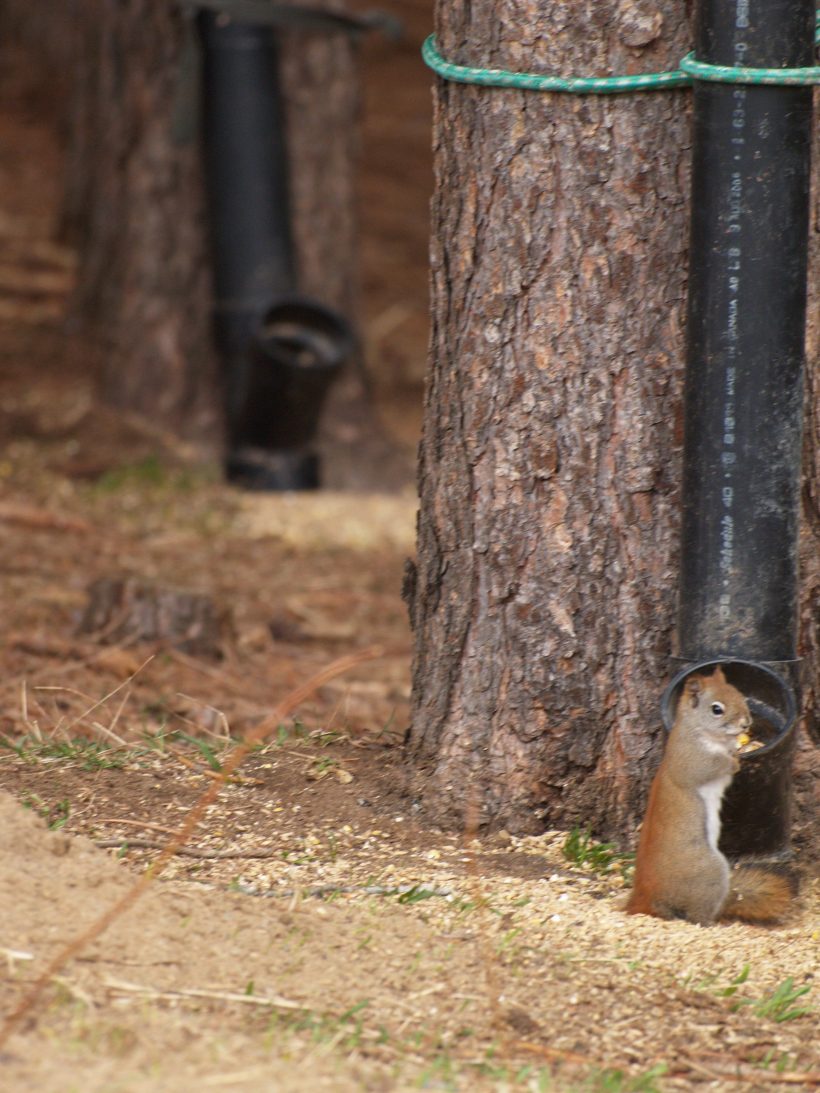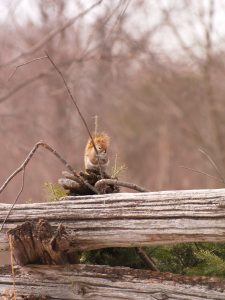 HARD HAT TIME
HARD HAT TIME
The red squirrels are busy once again dropping green hard as rock pine cones from great heights. If you are wandering about in the bush a hard hat might prove a worthwhile investment.
On one occasion TRW (The Resident Wife) discovered where a squirrel, we’re guessing, had collected and organized a lot of pine cones about the base of one red pine. All the pointy ends faced the tree and there were a lot of them encircling the base, several layers deep. Noone that I have ever asked has heard of such.
The red squirrel is quite territorial. We watched one day as one red squirrel collected and stored pine cones. Once it left to search for more a second squirrel would sneak in and steal some for itself. It wasn’t long before the miscreant was outted and the collecting squirrel put the chase on. This continued for some time.
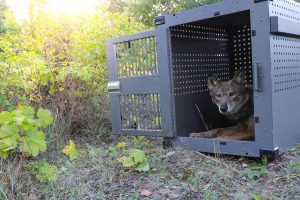
MICHIGAN WOLF SURVEY
During the winter of 2019 Michigan’s Department of Natural Resources’ wolf survey states that the wolf population has remained relatively stable for the past nine years. The survey estimates that there were a minimum of 695 wolves among 143 packs in the Upper Peninsula where Ontario once sent Algonquin moose for a re-introduction initiative during the 1980s. The survey is carried out from December through March when the population is at its lowest, before the pups are born.
Acting Chief of the Wildlife Division, Dan Kennedy, said the DNR has been surveying wolves since 1989 when they began naturally recolonizing the U.P. coming from Minnesota, Wisconsin, and Ontario. Perhaps as a result of the moose re-introduction?
“Our survey results continue to demonstrate that Michigan’s wolf population has recovered,” said Kennedy.
The survey is carried out by the DNR Wildlife Division and the U.S. Department of Agriculture Wildlife Services. In the spring wolves are live trapped and fitted with GPS collars that help researchers to determine pack boundaries .
“Given the relatively consistent abundance estimates since 2011 it appears the wolf population has likely reached the carrying capacity of the Upper Peninsula,” said Cody Norton, wildlife management specialist with the DNR’s bear, wolf and cougar program at Marquette.
Photo – courtesy DNR – of a wold about to release on Isle Royale.
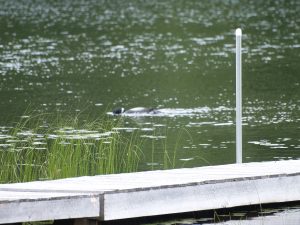
ACID RAIN and LOON CHICKS
Memories of Sudbury’s super stack. Built in 1970 to disperse sulphur gases and other byproducts of the smelting process away from the city this stack managed to alleviate the acid rain that had turned the landscape into a moonscape which had been used by astronauts who were training for a moon landing, in 1971.
Spread the pollution around Ontario. Acid rain was the climate change issue of that day. In 2020, after half a century, that stack is about to come down.
Recent analysis involving decades of research tells us that acid rain and mercury are still negatively impacting the number of loon chicks in Ontario. One might recall the discovery of mercury in Lake St. Peter which then begged the question, “What is the source of this mercury; after all there is no major industry here?”
Quite likely two factors were involved. One – new technology was able to identify mercury as being present. Two – the air currents carried and then deposited mercury in the lake. That was the then explanation as to how a chemical used to combat fire ants in the southern U.S. came to be discovered in Lake Ontario.
Back to the Chicks
For the past 38 years thousands of volunteers, including readers of this column, have participated in the Canadian Lakes Loon Survey managed by Birds Canada. Volunteers monitor loons and their chicks to help understand the long-term health of common loons and the health of the lakes where they live. According to the data from 1981 to 2018 the trend across southern Canada has been that the number of chicks raised per loon pair has decreased.
This is alarming because loons reveal a lot about the health of our lakes and the decrease in loon chicks suggest that the condition of the lakes is deteriorating. At present, loon populations are stable BUT declines in the number of loon chicks could forecast future declines in the number of adult loons.
Researchers measure loon reproductive success by looking at the number of six-week-old chicks produced per pair per year. By six weeks the chicks are about two-thirds the size of an adult loon and are better able to evade predators such as snapping turtles, bass and bald eagles. I would imagine that one could add pike and muskie to that list. The study indicates that Ontario is on the slippery slope to fewer chicks and fewer adult loons.
Acid Lakes
Research shows that loon chick numbers are declining faster on lakes with higher acidity and mercury levels. Due to atmospheric conditions more of the chemicals have been deposited in the east than in the west and as a result more lakes were acidified in Ontario, for example, than in western Canada.
Acid rain releases toxic metals such as aluminum into the water which interferes with the way in which a fish’s gills function and this ultimately results in decreased fish growth, reproduction and survival. Fewer fish means less food for loon chicks to grow and to survive.
Mercury also accumulates in the loon, one of the lake’s top predators. Mercury causes loons to incubate less, feed the chicks less and as a result raise fewer chicks. Warmer temperatures also allow more mercury to enter the food chain.
If you cottage or live on a lake you can make your property loon friendly by letting native wetland plants grow along the shoreline to provide food and shelter for the chicks. Slow down and minimize your boat wake, especially when approaching the shore to avoid washing out loon nests and separating small chicks from their parents. Keep the lake clean of garbage and free of fishing lines to avoid injury to the birds and attracting predators.
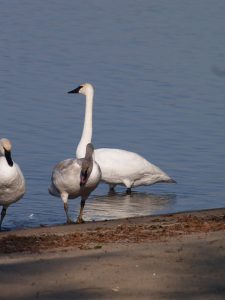
THE TRUMPETER SWAN
At one time these magnificently large white birds covered the continent. However, during the 18th and 19th centuries they were hunted to the brink of extinction. Pioneers could feed on a bird for days and the wealthy fashion folk fancied their large white plumes. The bird’s feathers provided quills for writing and adorned hats. There was no season or hunting limits at those times for the Trumpeter swan.
Additionally pioneer farming practices altered the landscape by draining wetlands for development that were favoured by these large birds.
North America’s largest native waterfowl, the Trumpeter’s wingspan measures nearly ten feet (that’s the height of a basketball net) , they stand near six feet tall and weigh in at more than twenty-five pounds; almost doubling the size of a Tundra swan. They require up to 100 yards for take-off.
Usually the Trumpeter mates for life beginning at ages 3 or 4, with some exceptions.
During incubation, instead of sitting on the eggs, Trumpeters warm the eggs by covering them with their big webbed feet. Because they have short legs set behind their centre of gravity walking can be somewhat less than graceful but they have been known to hike for more than a mile.
In the wild they have been recorded living as long as 26 years; in captivity – 32.
The Trumpeters seen in the accompanying photo had stopped over at Wollaston Lake in November during the 2013 deer hunt.

CARIBOU UP-DATE
Not only are the 9 woodland caribou that were relocated, as covered in this column, from Lake Superior’s Michipicoten Island to the Slate Islands in 2018 surviving; they appear to be thriving. An Ontario Species at Risk, the MNRF transplanted the 9 to save them from the wolves.
Art Rodgers, MNRF Research scientist, said that as far as they can tell the caribou are doing fine. The ministry is monitoring them with tracking equipment and 15 trail cameras. The 8 cows have GPS collars; the lone bull not so. The 9 supplemented the few bulls that were already on the Islands.
At that time 7 of the 8 cows were pregnant and at least 6 had calves in 2018. In 2019 at least 5 of the 8 gave birth again bringing the estimated population to 30 animals.
So far there are no wolves and no ice bridge has occurred to accommodate a crossing.
The calves born in 2018 are soon to be mature to begin breeding and this should exponentially increase the caribou population.
Presently there are an estimated 5000 woodland caribou in Ontario. They range north of Sioux Lookout, Geraldton and Cochrane with a few isolated caribou along the shoreline and islands of Lake Superior.
Photo – MNRF – June 2020 update
NUTRIENT ISSUES
For decades the Great Lakes have had a nutrient issue. In the 1960s Lake Ontario was suffering from too much phosphorus which inspired companies to remove it from laundry detergents, for example. Algae blooms abound along shorelines. Farm fertilizer runoff often is the culprit. But, according to the International Joint Commission which helps both Canada and the United States fulfill their obligations to ensure that the Great Lakes are environmentally suitable for swimming, drinking and fishing, the deeper offshore (20 metres plus) waters aren’t getting enough nutrients.
A June Commission report states that the decline in offshore nutrients is having a detrimental affect on fish populations. Ironically phosphorus is essential to the Great Lakes ecosystems impacting everything from plankton to the top predatory fish. Except for Lake Erie, the phosphorus levels in the deeper waters are below targets established by the Great Lakes Water Quality Agreement between Canada and the U.S.
The bottom line is balance. Too much can create algae blooms. Marc Gaden, Communications Director and Legislative Liaison for the Great Lakes Fishery Commission, asks if you curb nutrient inputs are you starving the fish? “This report is the first one I know that really address this topic” he said.
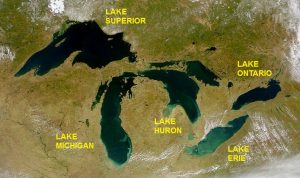
Some History
In 1972 Canada and the U.S. set limits regarding the amount of phosphorus permitted to enter each of the Great Lakes in the Great Lakes Water Quality Agreement (GLWQA) to control algal growth. According to Joseph DePinto, a primary author of the IJC report, “those phosphorous load targets were achieved in the 1980s; it was a great success.”
In the 1990s invasive Zebra and Quagga mussels were introduced to the Great Lakes and they upset the “apple cart”. The filter feeders clarified the nearshore waters and reduced the amount of phosphorus reaching the deeper waters. In short the mussels created a divided habitat – nearshore too much phosphorus, offshore not enough. “The phosphorus loads – what’s coming into the lakes – have not changed from 1990 to now,” said DePinto. “However, the concentrations in the water have gone up in the nearshore and down in the offshore, relative to what they were before mussels came in.”
Robert Hecky, a co-chair with DePinto of the IJC Science Advisory Board, raised the concern that prey fish numbers were declining and affecting the top predators in terms of growth and availability. A team of scientists from various disciplines are attempting to understand this issue. They discovered a clear relationship between forage fish (smaller prey fish) and nutrient levels. Lower phosphorus levels led to lower zooplankton growth which is the prey fish food. “The theory,” said DePinto, “is that everything else being equal, if you have less phosphorus in the offshore waters, you’ll have lower production of the top predator fish.”
This problem varies from lake to lake. Erie, for example has no such concerns with low offshore productivity. Its challenge is still phosphorus reduction to stop algal blooms. Lakes Huron and Michigan are suffering the most damage to fish populations. Superior is showing indications that a problem exists. Lake Ontario is not struggling as much as Lakes Huron and Michigan but an observed decline in the lake’s prey fish is a warning sign. Presently, “the salmon fishery, which is the most economically important fishery on the lake, is still in relatively good condition,” said Hecky, but they want to be aware of any changes as early as possible.
Fundamentally, the conundrum remains: how to reduce nearshore phosphorus loading while increasing offshore nutrients.
The solution, in part, appears to be a more ecosystem-based approach which will require an end to the separation between water quality and fisheries management. This has begun with the Great Lakes Water Quality Agreement of 2012 This recent IJC report is encouraging a multiagency approach involving state and provincial fisheries and environmental agencies as well as other national and Binational agencies. The report also calls for new mathematical models that at present do not exist to be developed that include all parts of the ecosystem from nutrients through the top predator fish. Sound complicated? You bet
Photo – Wikipedia
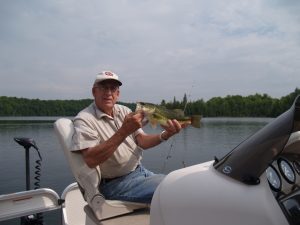
CARBONATED CURE?
Apparently not everything goes better with Coke. At least when it comes to first aid for gill damaged fish.
Steven J. Cooke, a Biology professor at Carelton University, co-ordinates a lot of fish studies carried out by students in his lab. Readers may recall reading about them in this column. This particular study addressed the concept that treating a fish’s damaged gills with Diet Coke, Mountain Dew, or other carbonated drinks would bring the fish back to better health.
The proposed theory suggested that carbon dioxide restricts the blood vessels and halts any bleeding gills.
Grad student Alexandria Trahan, a member of the Fish Ecology Conservation and Physiology lab, headed up the research which involved catching 156 Northern pike in the Rideau River system. Gill injuries were simulated using pliers to remove a one-centimetre section of a fish’s gills after which a carbonated beverage, including carbonated lake water, was applied. A control group had nothing applied to the injury.
The researchers suggest that possibly when the fish exits the water air induces hypoxia which slows the fish’s heart rate before the carbonated beverage is applied thus leading to the myth being studied.
The study, finalized in June 2020, provides “the first evidence that counters the growing popularity of using carbonated beverages to stop bleeding in angling-caught fish. We found no benefit or disbenefit with pouring carbonated beverages over the gills of northern pike, but it is possible there are longer term impacts.”
Further, “These findings provide direct scientific evidence that the use of carbonated beverages does not curtail bleeding from gills, which is counter to anecdotal observations made by recreational anglers that use this technique. Overall, our study debunks the assertion.”
